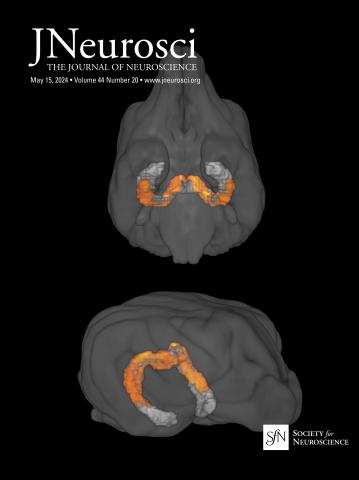Hearing loss and audiogenic seizures induced by hypofunctional prestin variants.
IF 4.4
2区 医学
Q1 NEUROSCIENCES
引用次数: 0
Abstract
Prestin's voltage-driven motor activity confers sound-elicited somatic electromotility on auditory outer hair cells (OHCs) and is essential for the exquisite sensitivity and frequency selectivity of mammalian hearing. Lack of prestin results in ∼50 dB hearing threshold shifts across frequency, supporting the causal association of the prestin-coding gene, SLC26A5, with hereditary hearing loss, DFNB61. However, ∼50% reduction in prestin-mediated OHC electromotility barely affects cochlear function, and it is currently unknown how much electromotility is minimally required to support normal hearing. We generated mouse models harboring two deafness-associated prestin variants, p.A100T and p.P119S, and found that these missense variants do not deprive prestin of its fast motor function but significantly reduce membrane expression, leading to 70-80% reductions in OHC electromotility. Homozygous and compound heterozygous mice of either sex for these missense variants suffered congenital hearing loss; however, they still retained relatively low hearing thresholds at lower frequencies, pointing to the clinical possibility that a small augmentation of OHC electromotility could benefit those with DFNB61 hearing loss. These mice were also found to be prone to audiogenic seizures. This study thus provides insights into the minimum OHC electromotility required for normal cochlear operation and reveals the unappreciated importance of prestin for central gain control.Significance statement Prestin is abundantly expressed in the auditory outer hair cells and is essential for normal cochlear operation. Hence, reduction of prestin expression is often taken as indicative of reduced cochlear function in diseased or aged ears. However, this assumption overlooks the fact that cochlear function can tolerate surprisingly large reductions in prestin motor activity. DFNB61 mouse models generated and characterized in this study provide an opportunity to gauge the amount of prestin motor activity needed to sustain normal hearing sensitivity. This knowledge is crucial not only for understanding the pathogenic roles of deafness-associated variants that impair OHC electromotility but also for unraveling how prestin contributes to cochlear amplification.功能低下的prestin变异引起的听力损失和听源性癫痫发作。
Prestin的电压驱动运动活动赋予听觉外毛细胞(ohc)声音诱发的体细胞电运动性,这对哺乳动物听觉的灵敏度和频率选择性至关重要。prestin缺乏导致约50 dB的听力阈值跨频率偏移,支持prestin编码基因SLC26A5与遗传性听力损失DFNB61之间的因果关系。然而,pretin介导的OHC电动力降低约50%几乎不会影响耳蜗功能,目前尚不清楚支持正常听力所需的最低电动力是多少。我们建立了含有两种与耳聋相关的prestin变体p.A100T和p.P119S的小鼠模型,发现这些错配变体不会剥夺prestin的快速运动功能,但会显著降低膜表达,导致OHC电运动性降低70-80%。这些错义变异的纯合子和复合杂合子小鼠,无论性别,都会遭受先天性听力损失;然而,在较低的频率下,他们仍然保持着相对较低的听力阈值,这表明轻微增加OHC电动力可能有益于DFNB61听力损失患者。这些小鼠还被发现容易发生听源性癫痫发作。因此,这项研究提供了正常耳蜗手术所需的最小OHC电动力的见解,并揭示了普司汀对中央增益控制的重要性。Prestin在耳蜗外毛细胞中大量表达,是正常耳蜗手术所必需的。因此,prestin表达的减少通常被认为是患病或衰老耳蜗功能下降的指示。然而,这一假设忽略了一个事实,即耳蜗功能可以承受惊人的前驱运动活动的大幅减少。在本研究中生成和表征的DFNB61小鼠模型提供了一个机会来测量维持正常听力灵敏度所需的prestin运动活动的量。这一知识不仅对理解耳聋相关变异损害OHC电运动性的致病作用至关重要,而且对揭示prestin如何促进耳蜗放大也至关重要。
本文章由计算机程序翻译,如有差异,请以英文原文为准。
求助全文
约1分钟内获得全文
求助全文
来源期刊

Journal of Neuroscience
医学-神经科学
CiteScore
9.30
自引率
3.80%
发文量
1164
审稿时长
12 months
期刊介绍:
JNeurosci (ISSN 0270-6474) is an official journal of the Society for Neuroscience. It is published weekly by the Society, fifty weeks a year, one volume a year. JNeurosci publishes papers on a broad range of topics of general interest to those working on the nervous system. Authors now have an Open Choice option for their published articles
 求助内容:
求助内容: 应助结果提醒方式:
应助结果提醒方式:


